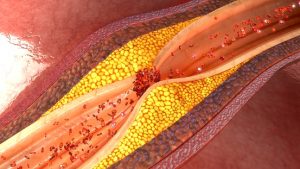 Peripheral artery disease is a disorder where the arteries that supply blood to the limbs become narrow. This results in insufficient blood supply and often leads to leg pain while walking. It could also be the result of arteriosclerosis caused by fat deposits.
Peripheral artery disease is a disorder where the arteries that supply blood to the limbs become narrow. This results in insufficient blood supply and often leads to leg pain while walking. It could also be the result of arteriosclerosis caused by fat deposits.
Traditionally, the disease has been associated with risk factors such as smoking, high blood pressure, diabetes, and high cholesterol. However, a paper recently published in Lipids in Health and Disease found a link between the condition and diet.
Advertisement
Researchers in China studied the dietary patterns of people and the risk of peripheral artery disease. They considered different aspects of the diet including vitamin intake and the quantity of trans-fatty acids.
Participants in the study
Researchers gathered data of 4,864 participants in the United States’ National Health and Nutritional Examination Surveys, which were conducted between the years 1999 and 2002. About 5.5 percent or 269 of these participants were diagnosed with peripheral artery disease.
Dietary patterns observed
Researchers analyzed the demographic and biochemistry data of the participants and identified three main dietary pattern-based parameters related to food groups.
- Dietary pattern 1 (DP1) comprised cholesterol parameters such as saturated fat, cholesterol, mono-unsaturated fatty acids, and total fat.
- Dietary pattern 2 (DP2) was based on nutrient intake and comprised vitamins, minerals, and fiber.
- Dietary pattern 3 (DP3) mainly comprised polyunsaturated fatty acids.
Findings of the study
Researchers investigated the relationship between the development of peripheral artery disease and dietary patterns (DP), plasma vitamins, and trans-fatty acids. The findings can be summarised as follows:
- Patients with peripheral artery disease had significantly higher levels of trans-fatty acids and low levels of vitamin D and retinol (Vitamin A).
- Men who did not suffer from peripheral artery disease had a higher intake of dietary nutrients such as vitamins, fiber, and polyunsaturated fatty acids, unlike men who had peripheral artery disease.
- Participants who did not suffer from the disease consumed more vitamin-enriched food and less trans-fatty acids.
Advertisement
Scientists also observed a negative correlation between dietary patterns 2 and 3, and the severity of the condition. In other words, people who consumed more vitamins, minerals, polyunsaturated fatty acids, and fiber were less affected by peripheral artery disease.
Two conclusions can be drawn from the findings:
- A diet that is enriched with such nutrients can prevent if not delay the disease from developing.
- Diet has a role to play in the development or severity of peripheral artery disease. Hence, a diet of foods that contain trans-fatty acids and less fiber, vitamins, and minerals is one of the risk factors for the disease.
The findings are significant as they show that a person’s diet can be used as a benchmark to identify the potential risk of developing peripheral artery disease. If a doctor identifies such a risk, the person can be given dietary advice in order to reduce the risk.
Related: Study reveals high mortality linked with coronary artery disease: Study
